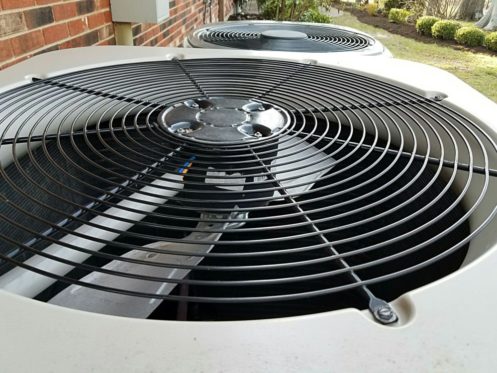If you want to replace the HVAC system in your home, getting one that offers a high level of efficiency for cooling should be at the top of your list. Finding a more efficient air conditioner translates to lower operating costs over the system’s lifespan.
Your HVAC contractor will talk to you about energy efficiency and SEER ratings while in the process of installation. Read on to find more about SEER ratings and why it’s important to your HVAC system.
What Is a SEER Rating?
Let’s start by understanding what SEER stands for. SEER is short for Seasonal Energy Efficiency Ratio, and it represents the efficiency of your heat pump or central air conditioner. It is basically the ratio of the air conditioner’s cooling output to the amount of energy it consumed during the cooling season. It can also be referred to as a Seasonal Energy Efficiency Rating.
The Air Conditioning, Heating, and Refrigeration Institute developed the standards to help customers easily identify an air conditioner’s efficiency. Therefore, the SEER rating helps assign a specific number to a unit, representing its efficiency. As the SEER rating increases, the more the heat pump or air conditioner’s efficiency will be.
What’s the Ideal SEER Rating?
There’s no SEER rating ideal for everyone because it varies with different homes and locations. For example, if you have a huge house in an area with warm, humid weather conditions, a 20-SEER could be appropriate for you, for example.
Your HVAC professional can identify the ideal rating to achieve your desired home’s comfort, utility bills, and environmental impact. Fortunately, you can find various options that meet different comfort goals and budgets.
HVAC systems can have ratings as high as 26 depending on the model and brand, and it doesn’t necessarily mean that the top SEER rating is the best for you. Your goals and needs determine the appropriate unit for you, but most contractors may recommend systems with at least 16 SEER.
All heat pumps and air conditioners will cool your space to the set temperatures irrespective of their SEER rating. However, a highly rated one will deliver more efficiently, saving you some money.
Advantages of High SEER Ratings
A system’s SEER rating is among the key factors to consider while deciding. Below are some benefits of having high-efficiency systems rated with high SEER.
1. Comfort
HVAC units with top SEER ratings provide more comfort than low-rated ones. The high-efficiency systems tend to offer variable speed and two-stage cooling that increases your home’s comfort.
The entry-level systems, for example, with 13-SEER, offer single-stage cooling. This means that they can only run at one speed, and they’ll often turn on and off in mild weather causing uneven cooling. They are also likely to struggle with cooling multiple stories because of their reduced runtimes, not forgetting their noisy natures, which you may find annoying.
Two-stage cooling systems include a lower setting, say around 70% capacity, and the full is around 100% capacity. The lower capacity setting allows the system to preserve your home’s temperatures better, hence fewer temperature fluctuations. The two-stage cooling systems are usually in the SEER range of mid-efficiency.
On the other hand, variable-speed systems have numerous settings, up to 700, with capacity ranging from 30% to 100%. These systems can alter their outputs to accurately retain your home’s temperature within this range. Variable-speed systems often have a SEER rating of 20 or above, making them the most energy efficient.
2. Lower Cost of Energy
The efficiency differences between two-stage, variable-speed, and single-stage cooling systems may appear confusing at times, mainly because variable-speed and two-stage systems run for longer periods than single-stage systems.
However, the extra settings on variable-speed and two-stage units are crucial to their higher SEER ratings. The configuration of the single-stage unit is developed with the warmest day of the season in mind.
The cooling period may see your single-stage system overcooling your home and frequently turning on and off, consuming more energy. For this reason, single-stage systems get a lower SEER rating than other modern alternatives available.
A two-stage system consumes less in comparison to a single-stage one because it can operate on its lower setting for a long period during cooling seasons. A variable-speed system can modify its energy usage because it has a variety of settings.
Besides a variable-speed system having a longer lifetime, its lower setting reduces the number of energy spikes and, as a result, cheaper energy costs. It is these benefits that make these systems be ranked highest on SEER.
3. Financial Incentives
With some HVAC systems, you can save money on more than just your electricity bill. Units with high efficiency may also provide refunds and tax benefits, allowing you to save money.
Utility companies and manufacturers often offer high-efficiency systems incentives that aren’t obtainable with entry-level systems. The incentives available may vary by year, state, and area, but the HVAC contractor should be able to ascertain what is available.
4. Cooling Benefits
Variable-speed and two-stage systems reduce humidity levels in your home more than single-speed systems. The more time you keep your air conditioner running, the more humidity it removes from the air. A longer-running system distributes air more evenly, which is beneficial if your home has multiple stories.
If your house has more than one story, a single-stage cooling system will give your ground floor the best cooling since it is closest to the HVAC system. However, the upper floors and attics may not have adequately distributed conditioned air.
Factors to Consider While Choosing the Best SEER Rating
Below are some pointers to help you arrive at the best SEER rating for your home.
Determine Your Goals for the New HVAC System
What are your objectives with a new air conditioner? You probably don’t need a heat pump or an air conditioner with the best SEER rating if you’re happy with your current energy bills but intend to minimize your initial spending. However, if you want to save money on energy or reduce your environmental effect, a higher SEER rating HVAC system is ideal.
The Climate of Your Residential Area
During the summer, how long do you leave your air conditioner on? If you have it on a lot during the warmer months, you might want to save some money by using a high-efficiency unit.
Structure of Your Home
What is the number of stories in your house? High-efficiency systems may be ideal if you have a multi-story house.
Other Equipment
When hunting for a new HVAC system, you might want to replace a few other things like your furnace. If you don’t intend to do so, it is vital to ensure your existing equipment is compatible with the new system. No matter what SEER number your air conditioner has, if your equipment doesn’t match, you won’t obtain the efficiency you so badly wanted.
A magic SEER number does not exist, and anything over 13 is considered efficient. Upgrading from a lower SEER system to a more highly rated unit will significantly drop your energy costs. Remember to look into tax benefits and manufacturer incentives that might help you save money on a high SEER system and get ready to enjoy the perks.
Contact Environmental Heating & Air Solutions if you want to invest in a new HVAC system in northern California. We can help you select the right energy-saving choice for your house. Check out our website for more on our cooling, heating, air quality, and plumbing services and book your appointment.

